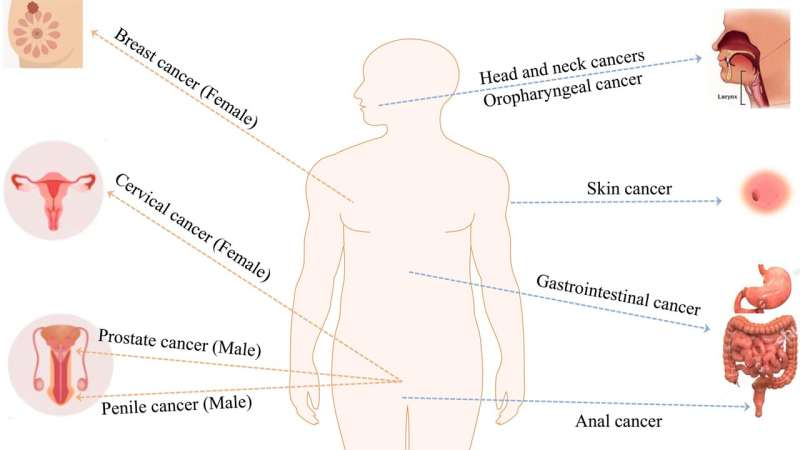This article has been reviewed according to Science X's editorial process and policies. Editors have highlighted the following attributes while ensuring the content's credibility:
fact-checked
proofread
Team reports on prevalence in Middle East of cancers associated with human papillomavirus

Human papillomavirus (HPV) is a pivotal etiological factor in the development of several cancers, with a profound impact on global public health. It is estimated that 50–70% of sexually active individuals are infected with HPV at some point in their lives. HPV is responsible for more than 5% of all cancers, including cervical, penile, vulvar, vaginal, anal, and oropharyngeal cancers.
The virus is categorized into five phylogenetic groups: α, β, γ, µ, and ν, with the α group containing the high-risk types most frequently associated with malignancies. The oncogenic potential of HPV is primarily attributed to its E6 and E7 oncoproteins, which interfere with critical cell regulatory pathways.
The Middle East, including Iran, exhibits a considerable prevalence of HPV, with an increasing incidence of HPV-induced cancers. Traditionally, conservative sexual customs in this region have contributed to lower HPV exposure. However, recent sociocultural shifts towards more liberal premarital sexual behaviors have resulted in higher HPV transmission rates. The region's public health infrastructure has yet to adequately respond to this emerging challenge, particularly in terms of vaccination and screening programs.
Recent research on this topic appears in the journal Exploratory Research and Hypothesis in Medicine.
Globally, HPV accounts for 4.5% of all cancer cases, with a disproportionate burden on less developed regions. The highest incidence rates are observed in Sub-Saharan Africa, Latin America, and parts of Asia. While cervical cancer prevalence has decreased in Western countries due to effective vaccination and screening initiatives, it remains a significant health issue in many parts of the world and is on the rise among younger women in several regions.
HPV is a small, non-enveloped, double-stranded DNA virus that primarily infects epithelial cells. Its genome includes early (E) and late (L) regions, coding for regulatory and capsid proteins, respectively. Infection typically occurs through microabrasions in the epithelium, allowing the virus to bind to specific cell receptors.
High-risk HPV types are known for their integration into the host genome, which disrupts the E1 and E2 genes. This disruption leads to the overexpression of the E6 and E7 oncoproteins, which in turn inactivate tumor suppressor proteins such as p53 and retinoblastoma (Rb). The inactivation of these proteins results in uncontrolled cellular proliferation and the potential for malignant transformation.
HPV has evolved mechanisms to evade the host immune system, contributing to persistent infections and an increased risk of cancer. The virus achieves immune evasion by downregulating antigen presentation and modulating the host's immune response. This includes reducing the expression of interferon-stimulated genes and altering the function of antigen-presenting cells and T-cells, thereby impairing the host's ability to mount an effective immune response.
Cervical cancer is the most prominent malignancy caused by HPV, with persistent infection by high-risk HPV types being the primary causative factor. The progression from HPV infection to cervical cancer involves several stages, beginning with the initial viral infection, followed by the integration of viral DNA into the host genome, and culminating in the invasion of the epithelium's basement membrane.
In Iran and the Middle East, cervical cancer remains a significant public health issue, with a high prevalence of HPV infection. Genotyping and vaccination are critical tools in the prevention of cervical cancer, with vaccines targeting HPV types 16 and 18 being the most effective.
Vaccination is a cornerstone of HPV prevention. The introduction of prophylactic vaccines, particularly those targeting HPV types 16 and 18, has significantly reduced the incidence of HPV-related cancers in vaccinated populations.
In the Middle East, however, vaccination programs face several challenges, including cultural barriers, limited public awareness, and inadequate health care infrastructure. To effectively combat the rising trend of HPV-associated cancers, it is essential to implement comprehensive public health strategies that include widespread vaccination, public education campaigns, and enhanced screening programs.
The review highlights the urgent need for robust HPV control strategies in Iran and the Middle East. With the increasing prevalence of HPV-induced cancers due to changing sexual behaviors and inadequate vaccination coverage, there is a critical need for improved public health initiatives.
Strengthening vaccination programs, enhancing early detection methods, and raising public awareness about HPV and its associated risks are crucial steps in mitigating the burden of these cancers in the region. By addressing these challenges, the Middle East can better manage and reduce the incidence of HPV-related malignancies, ultimately improving public health outcomes.
More information: Hossein Bannazadeh Baghi et al, Cancers Associated with Human Papillomavirus: An Overview of Prevalence in Iran and the Middle East, Exploratory Research and Hypothesis in Medicine (2023). DOI: 10.14218/ERHM.2023.00053



















